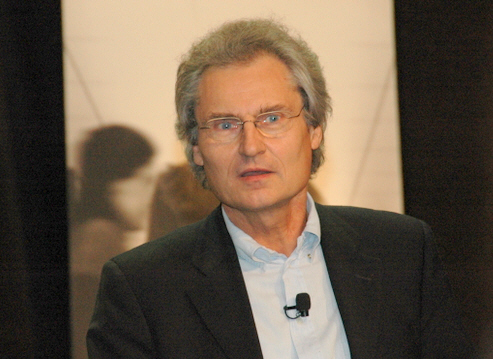SAP bets on enterprise SOA, but are customers ready?

"It’s not necessary to buy companies to get growth,” said SAP CEO Henning Kagermann, speaking at the company’s fourth annual analyst summit. He was referring to rival Oracle’s approach to growth, spending more than $20 billion on acquisitions, and pointed to SAP’s 11 consecutive quarters of growth and market share gains as evidence that his company’s organic growth path has been validated.
However, the majority of his remarks were about the transformation from a vertical product-centric architecture into a horizontal customer-centric architecture, which SAP terms “enterprise SOA.”

Traditional vertical integration is tightly coupled, and ends up being inflexible and insular, and the horizontal approach is more loosely coupled and adaptive, built for an era of specialization. “You have to deal with integrating processes into heterogeneous environments,” Kagermann said.
“Enterprise SOA is available today, and SAP is the only company that can provide it,” Kagermann claimed. “All of this is in place, nothing is missing.” SAP enterprise SOA strives to follow all the latest themes of software today--horizontal, open, integrated, standardized, lower TCO, embedded services (such as compliance and analytics), and lighter weight.
“We take 50 percent of the upgrade cost away,” Kagermann said, applying the enterprise SOA approach to ERP software, and without major disruption to customers operations. However, he didn’t say how SAP would make that happen, especially related to migrating data and dealing with customizations.
The foundation of SAP enterprise SOA is NetWeaver, with MySAP ERP as the application platform that uses the enterprise Web services. SAP will have about 1,000 enterprise services at the end of the year, Kagermann said.
He also claimed that SAP has the first business process platform, with enterprise services, composite applications, enhancement packages, an integrated composition environment, and coverage of all industries.
He added that the current version, mySAP ERP 2005, with 400 live customers, will continue to evolve with enhancement packages, but a new suite is not expected until 2010. In 2007, SAP expects to have a mid-market platform to complement mySAP ERP for large enterprises and to develop a mySAP Business Suite on a business process platform, Kagermann said.
By 2010, Kagermann said that 50 percent of SAP revenue will come from new products, and two-thirds of installed based will deploy Enterprise SOA, and the company will have more than 100,000 customers, with about 40- to 45-percent in the mid-market.
I asked Bruce Richardson chief research analyst at AMR Research, who was sitting next to me about Kagermann’s vision of SAP’s future.
“The strange thing is that if you talk to SAP partners around the world, there doesn’t seem to be a lot of demand from big SAP customers for SOA,” Richardson said. “They know SOA is coming, but they want to know how much it will cost, how long to take, and how to make case to their CEO.”
“The world of SOA as initially envisioned can be segment into big SOA with the entire stack and embedded Web services, but today we see little SOA, with replacement for EAI and point-to-point integration. We are just taking some baby steps. It’s a more realist story that true enterprise SOA plays out over longer horizon. It puzzles me that Oracle and SAP are focusing so much on this when big customer don’t care,” he added.
SAP may have a better shot at growing faster in the mid-market. The company is expected to unveil a new set of applications next year build from the ground up based on Web services and model based development.
"It is hard to generate excitement about an evolutionary approach," said Jim Shepard, a senior vice president at AMR Research. "By it's nature it doesn't generate market buzz, competitive pressure or buying frenzy. Large clients can't handle big changes, and SAP doesn't want to jeopardize relationships with large clients. Maybe the new mid-market offering will be a good way get a positive response to a more radically different platform."